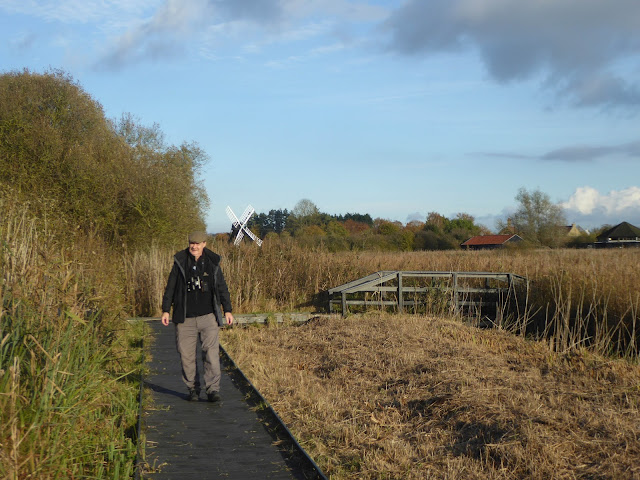The promise of late autumn sunshine lured us out
with a picnic lunch to NT Wicken Fen
for some fresh air, bright colours and wide skies.
There are two windpumps in the village:
you can read about the other one
here.
The colour red was represented by berries (above) and leaves (below)...
not forgetting...
rosehips.
The photo above was taken as the light began to fade, but I am posting it because it represents a term,
the Duffey heap, that is new to me. A Duffey heap comprises grasses which are known in this fenland area as 'litter'. The grasses are cut in a three year rotation in late summer once they have gone to seed. The harvested litter is then moved from an area of tall herb fen to the corner of the reserve you see in the picture above. These heaps are named after Eric Duffey, who was a regular visitor to the site. You can read a sample of his work
here, including his thoughts on the value of these heaps.
Duffey was President of the British Arachnological Society (BAS) from 1969-73. He discovered the magnificent Fen Raft Spider in Suffolk, a species that suffered decline, and is only now coming back a little, thanks to massive conservation initiatives. You can read more about the Fen Raft Spider here, and this
linked Dolomedes page, which has a link to my Fen Raft Spider
poem.
Back to Wicken Fen, and here we are by the entrance to the reserve. You can take a delightful boat trip along the
lode on the Mayfly during summer months, with commentary about the fenland life of eel-catchers and others.
The molehill below may not represent the brightest of autumn shades,
but just look at the colour of the dark peat soil.
Despite beautiful birdsong, we saw very few birds:
the sparrows below were hiding in the branches...
This is the fenman's cottage, showing the drooping heads of two sunflowers.
There were still a few bright orange bursts of marigold in the garden.
The sheds and outhouses hold an array of fenland bits and pieces...
We are still adjusting to the hour change: this was probably only about 4pm...
...but we do love the drama of the wide fenland skies.
More berries...
... and this is one of the few insects we saw today.
I wonder if it is a species of Longhorn: I shall try to find out.
There were tranquil reflection...
along the lode...
and a beautiful light at times.
I am more of spring-to-summer person,
but I find autumn colours hard to resist...
... and, of course, each season
has its own abundance
of treasure.
Sails and shadows
We saw a couple of Muntjac deer in the distance.
Here is one of them...
Due to damp ground, some parts of the reserve were fenced off,
but there was a new section to explore, a woodland walk...
The sign led us past...
...what I imagine may be an old pumping station.

These arches above were presumably for drainage.
And finally, corvids began to gather as the light faded.
We enjoyed cups of tea in the gloaming before heading home.
Postscript
In my
previous post I mentioned not only the from the Oxford Junior Dictionary but also the chance, as part of the Land Lines project, to vote for your
#favnaturebook ... There are so many excellent nature books being produced at the moment. In connection with my visit to Wicken Fen, I wanted to mention
Cuckoo by Cambridge scientist,
Professor Nick Davies. This beautiful and fascinating book is published by Bloomsbury; and many, possibly even most, of the cuckoos between the covers spend part of the year at Wicken Fen.
























































